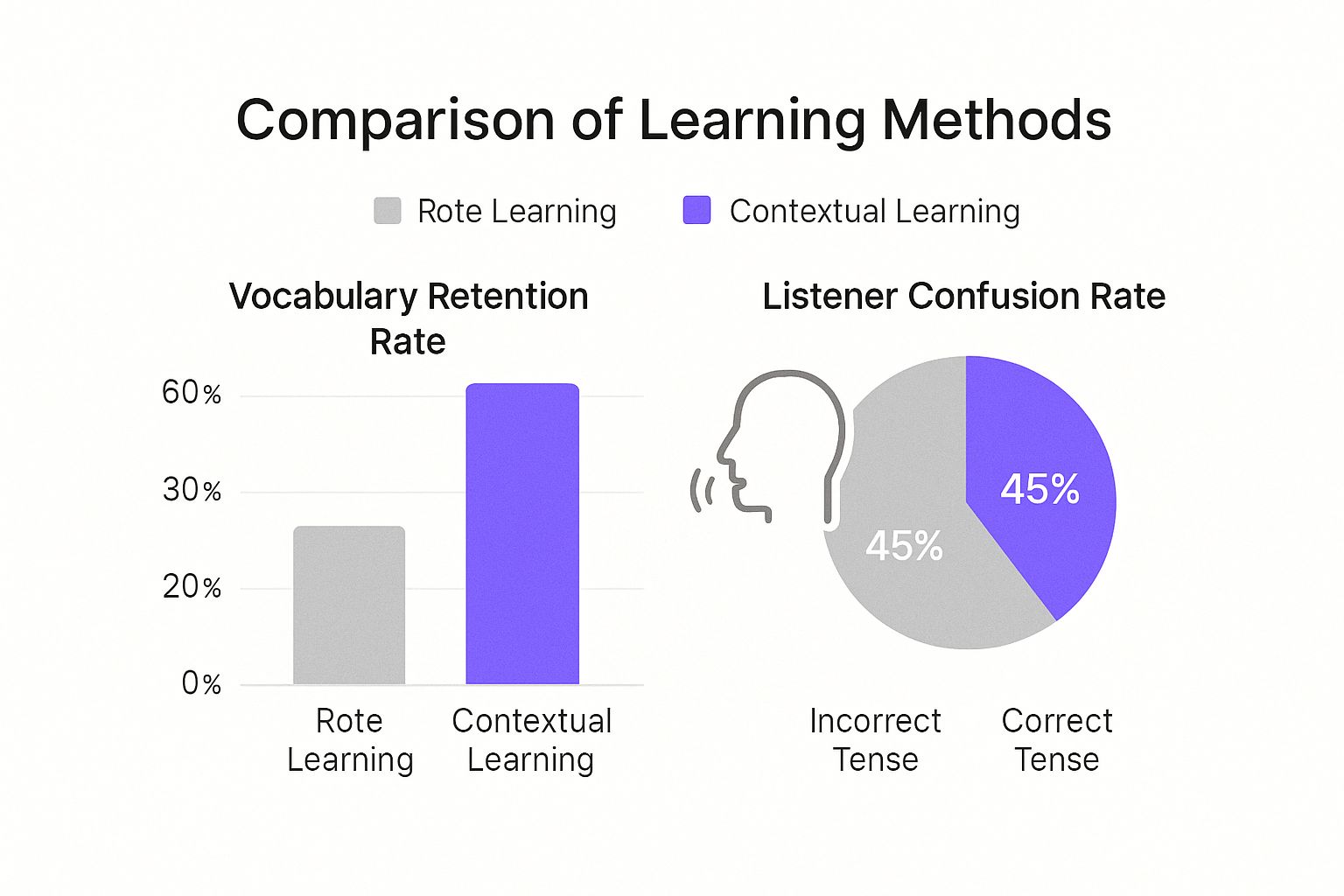How to Talk Correctly for Clearer Communication
Struggling to be understood? Learn how to talk correctly with our guide on pronunciation, grammar, and flow for more confident conversations.


Learning to speak more accurately isn't about chasing some robotic idea of perfection. It’s really about building the confidence to connect with people and make sure you’re understood—whether you're just chatting with friends or giving a big presentation at work.
We're going to focus on four key areas: getting your pronunciation right, using grammar that actually works in conversation, picking the right words, and finding a natural rhythm.
Why Speaking Clearly Is a Confidence Game

Let's be real—we've all felt that knot in our stomach right before we have to speak up. You worry you’ll be misunderstood, judged for a small grammar mistake, or just stumble over your words. It’s a universal feeling.
This guide isn't about memorizing the dictionary or sticking to stuffy, outdated rules. It’s about shifting our perspective on what "talking correctly" even means. The real goal is clarity and connection.
When your words land just right and your message is heard, something shifts inside you. Your self-esteem gets a boost. You stop overthinking every little thing you say and start jumping into conversations more freely. That confidence isn't just in your head; it has a real impact on your life and career.
How Clear Speech Opens Doors in the Real World
Being a clear communicator is a genuine superpower. It's the bedrock of strong relationships, successful careers, and effective leadership. Think about it—in the workplace, this skill is everything.
In fact, a whopping 57% of employers worldwide say strong communication skills are what they value most in new hires. That makes perfect sense when you consider that an incredible 86% of employees and executives blame most workplace failures on poor communication.
When you nail your spoken communication, you can:
- Explain your ideas persuasively in meetings.
- Build a much stronger connection with clients and colleagues.
- Handle social situations with way less stress.
- Advocate for yourself and your career path more effectively.
This is all about giving you the tools to be yourself, just more clearly and confidently.
The goal is not to sound like someone else, but to become the most articulate and understandable version of yourself. True confidence comes from knowing you can convey your thoughts clearly, no matter the audience.
The Four Pillars of Clear Communication
To break this down into manageable pieces, we'll focus on four core areas. Think of them as the pillars holding up your communication skills. Each one supports the others, creating a solid foundation for you to build on.
This table gives you a quick overview of the key components we'll cover to help you speak more effectively.
| Pillar | What It Means for You | Why It Matters |
|---|---|---|
| Pronunciation | Making sure your words sound clear and distinct. | Listeners can understand you easily without having to strain. |
| Grammar | Using the right structures to build clear sentences. | Your message is logical and doesn't get misinterpreted. |
| Vocabulary | Choosing the most precise and effective words. | You can express exactly what you mean with more nuance. |
| Fluency | Speaking with a natural rhythm and smooth flow. | You sound more confident and are more engaging to listen to. |
By working on these four areas, you’ll develop a well-rounded skill set for speaking with confidence. For some great daily exercises you can do on your own, check out our guide on how to practice English speaking.
Mastering Pronunciation and Enunciation

Have you ever felt that frustration of having to repeat yourself? You're definitely not alone. The actual mechanics of speaking—how we physically form sounds and shape words—are the foundation of being understood, yet they’re so often overlooked.
Mastering pronunciation isn't about chasing a "perfect" accent. It's about clarity. It’s about delivering your message with enough precision that your listener can focus on what you’re saying, not struggle to figure out how you’re saying it.
The good news? Your mouth, tongue, and lips are all controlled by muscles. Just like any other muscle group, you can train them for better performance. This isn't abstract theory; it's about dedicated physical practice.
Training Your Speech Muscles
Think of clear speech as a physical skill, much like playing an instrument. To get better, you need targeted exercises that build strength and coordination in your articulators (the parts of your mouth you use to talk). These drills aren't just for actors or public speakers; a few minutes a day can make a huge difference for anyone who wants to talk correctly.
Here are a few practical exercises you can start with today:
- Targeted Tongue Twisters: Go beyond the simple ones. For tricky "th" sounds, try repeating, "Thirty-three thirsty thieves thought that they thrilled the throne throughout Thursday." To nail plosive sounds like 'p' and 'b', work with "Peter Piper picked a peck of pickled peppers." The goal isn't speed, but exaggerated, precise articulation.
- Vowel Drills: Over-enunciating your vowels really opens up your speech. Stand in front of a mirror and say "EE-AH-OH-OO," stretching your mouth as wide as you can for each sound. It might feel silly, but this simple drill loosens your jaw and dramatically improves clarity.
The real secret to clear enunciation is intentional exaggeration during practice. By overdoing it when you're alone, you build the muscle memory that translates into natural, crisp speech in real conversations.
Adjusting Your Volume and Pace
Speaking correctly also means adapting to your surroundings. The way you talk in a quiet library should be completely different from how you speak in a loud, busy coffee shop. It all comes down to situational awareness.
Imagine trying to give your order in that noisy café. Most people's instinct is to just get louder, but this can lead to shouting and distorting your words. Instead, the real key is to slow down your pace and focus on hitting every part of each word. A slightly slower, more deliberate delivery cuts through background noise far more effectively than volume alone.
On the flip side, a loud voice can feel aggressive in a quiet one-on-one meeting. This is where you lower your volume and use a more moderate pace, adding emphasis with vocal variety instead of power. The ability to modulate your voice like this is a true hallmark of a skilled communicator. For those looking to refine their sound even further, our guide can help you learn an English accent with practical, easy-to-follow steps.
Spotting and Fixing Common Mistakes
Everyone has certain words or sounds they tend to trip over. The first step to fixing these is simply identifying them. A powerful, easy technique is to record yourself reading a passage from a book or a news article.
Now, listen back with a critical ear. Do you drop the "g" in "-ing" words (like saying runnin' instead of running)? Do you struggle with consonant clusters, like in the word "strengths"?
Once you've found a problem sound, isolate it. If you have trouble with the "r" sound, for example, practice words like "rural," "rarely," and "roar" very slowly. Say them one at a time, really concentrating on the tongue placement needed to produce that sound correctly. This kind of consistent, focused practice on your personal pitfalls will smooth out the rough edges in your speech, making you instantly easier to understand.
Using Grammar and Vocabulary in Real Conversations
Knowing grammar rules from a textbook is one thing. Actually using them in the heat of a conversation? That’s a whole different ball game. The secret to speaking English more accurately isn’t about memorizing every last rule—it’s about mastering the ones that truly matter for clear communication.
Think about telling a story. If you’re constantly mixing up past and present tenses, your listener is going to get lost. It’s like trying to follow a map with the directions all jumbled up. This is what we call conversational grammar—the practical rules that keep your speech clear and easy to follow.
Making New Words Stick
The same idea applies to building your vocabulary. Trying to memorize long lists of random words is a recipe for forgetting them. We’ve seen it time and time again. Our brains just aren't built that way. We remember words when they're attached to a feeling, a story, or a real-life situation.
This is the magic of contextual learning. You’re far more likely to remember the word "ubiquitous" if you learn it while reading an article about how Starbucks cafés seem to be ubiquitous on every street corner, rather than just seeing it on a flashcard.
This infographic really drives the point home, showing just how much context and accuracy matter.

The numbers are pretty stark: learning a word in context gives you a 60% retention rate, more than double that of rote learning. And getting your tenses right can slash listener confusion by 30%.
The Art of Self-Correction
Listen, even native speakers trip over their words. The real skill isn't about being perfect; it's about learning to correct yourself smoothly without grinding the conversation to a halt.
Let’s say you’re in a meeting and you accidentally say, "I think we should've went with..." You realize it the moment it leaves your mouth. Instead of freezing up, you can pivot gracefully.
- The slip: "We should've went with the first option."
- The fix: "Actually, let me rephrase—we should have gone with the first option."
It’s a quick, confident adjustment that shows you know your stuff. It doesn’t interrupt the flow; if anything, it reinforces your credibility.
Here’s a quick-reference table for some of the most common spoken grammar slips we hear.
Common Spoken Grammar Slips and Their Fixes
| Common Mistake | What to Say Instead | Quick Tip |
|---|---|---|
| "Me and my friend went..." | "My friend and I went..." | Always put the other person first, and test it by removing them ("Me went to the store" is wrong). |
| "There's many reasons..." | "There are many reasons..." | Use "is" for singular things and "are" for plural things. |
| "I could of/should of" | "I could have/should have" | The "of" sound is just a contraction of "have" (could've, should've). |
| "Less people were there." | "Fewer people were there." | Use "fewer" for things you can count (people, books) and "less" for things you can't (water, time). |
Keep this table handy—spotting these common errors in your own speech is a huge step forward.
The goal isn't to never make a mistake. It's to handle mistakes so smoothly that they become almost invisible. A quick correction is always better than letting an error hang in the air.
By focusing on high-impact grammar and learning vocabulary in a way that actually works, you’re building the real-world skills you need for clearer, more confident conversations.
Navigating Social and Professional Conversations

All the work you put into pronunciation and grammar pays off when you step into real-world conversations. These technical skills are your toolbox, but social and professional settings are where you actually build something. Being a great speaker isn’t just about getting the words right; it's about situational awareness—the ability to read the room and adjust on the fly.
One of the most powerful, and often overlooked, skills for this is active listening. It's a game-changer. When you stop just waiting for your turn to talk and truly hear what someone is saying, your responses become more thoughtful and relevant. It transforms a simple back-and-forth into a genuine connection.
This holds true everywhere, from making small talk at a party to pitching a crucial idea to your boss. Each scenario calls for a slightly different version of you, and getting that adaptability down is what separates good speakers from great ones.
Adapting Your Style for Different Audiences
Think about it: the way you explain a project to a fellow engineer is completely different from how you’d describe it to a client who has no technical background. With your colleague, you might dive into the jargon. With the client, you'd probably use simple analogies and focus on the bottom-line benefits. This is called code-switching, and it's a vital communication skill.
Let's look at two common scenarios:
- Networking Event: Your goal here is to be memorable and build rapport fast. Instead of the stale "What do you do?", try an open-ended question that invites a real story. Something like, "What was the most interesting challenge you worked on this year?" gets a much better response.
- Presenting to Your Boss: In this setting, clarity and brevity are king. Don't bury the lede. Start with your main point or request, then fill in the details. For example, open with, "I have a proposal that I believe could increase our team's efficiency by 15%."
Knowing how to sound professional is a massive advantage in these moments, and it really just boils down to picking the right level of formality for the situation.
The hallmark of a truly skilled speaker isn't a flawless vocabulary. It's the ability to make every single person feel like they are being spoken to directly and respectfully, no matter the context.
The Art of a Graceful Conversation
Knowing how to smoothly enter, navigate, and exit conversations is a practical skill that can seriously reduce social anxiety. A common hurdle is figuring out how to disagree without coming off as aggressive, or how to interrupt politely when you have something important to add.
For instance, if you need to challenge an idea, frame it constructively. Instead of a blunt, "That's wrong," try something that validates their point first: "I see what you're saying about the budget, but have we considered the impact on our timeline?" This simple shift turns a potential conflict into a collaborative discussion.
Similarly, if you absolutely must interrupt, wait for a natural pause and use a soft entry like, "If I could just add one thought here..." It's a sign of respect that allows you to contribute without derailing the conversation. These subtle techniques make a huge difference in how you're perceived, both socially and in the workplace.
Building a Consistent Practice Routine That Works
https://www.youtube.com/embed/6E7i_7Mr_5c
If you want to see real, lasting improvement in your spoken English, it won't come from a few intense study sessions. It comes from small, repeatable habits that you stick with day in and day out. The goal is to weave practice into your life so seamlessly that it just becomes part of your routine.
Remember, the key is consistency over intensity.
A simple but incredibly powerful first step? Record yourself. Just grab your phone, open the voice memo app, and talk for one minute about your day, a hobby, or anything you know well. We know, listening back can be a bit cringey at first, but it’s the quickest way to get an honest look at your own speech patterns, your go-to filler words, and your natural pacing.
This little bit of self-analysis is where targeted improvement begins. Once you hear what you need to work on, you can start slotting small, focused exercises into your daily schedule.
Low-Stakes, High-Impact Practice
You don’t need a formal audience or a high-pressure situation to get better. In fact, the best practice happens in low-stakes environments where you feel comfortable enough to experiment and make mistakes. This is where the real growth happens—away from the fear of being judged.
Here are a few simple methods that have a huge impact:
- Read Aloud Every Day: Seriously, just five minutes. Pick up a news article, a blog post, or a page from a book and read it out loud. It's a fantastic way to work on your rhythm and enunciation without having to worry about what to say next.
- Use Tech to Your Advantage: There are some great apps out there that give you instant feedback on your pronunciation. Playing around with one for a few minutes a day helps build muscle memory for tricky sounds, turning them from a struggle into a habit.
- Grab a Practice Buddy: Ask a supportive friend if you can practice with them. This doesn't have to be a formal lesson; it could just mean having more phone calls or picking a topic to discuss where you can focus on being more articulate. Feedback from someone you trust is gold.
The most effective practice is the one you actually do. It's far better to commit to five minutes of focused effort every day than to aim for an hour once a week and consistently miss it.
Finding Your Community
Practicing on your own is essential, but there’s no substitute for real conversation. Engaging with others is what turns theory into skill and builds the confidence you need. Joining a local group—like a book club, a hiking group, or any hobby club—creates a natural, easygoing environment for conversation.
The beauty of these settings is that the focus isn't on perfect speech; it's on a shared interest, which takes all the pressure off. You get to apply what you've been practicing in a real-world context, slowly turning that conscious effort into unconscious competence.
These small, daily actions really do compound over time, leading to huge improvements in how you communicate. And if you're looking for more, our team at TalkEasy is always creating new tools to help you on your journey.
Answering Your Lingering Questions About Clear Speech
Even with a solid game plan, certain questions always seem to pop up when you're working on speaking more accurately. Let's tackle some of the most common ones we hear from people trying to polish their spoken English.
Think of this as your go-to troubleshooting guide for those final, nagging hurdles.
How Can I Stop Saying 'Um' and 'Like' So Much?
This is a big one. The best tool for fighting filler words is something you already have: the pause.
When you feel an "um" or "like" about to jump out, just stop. Take a silent breath. It might feel awkward at first, but to the person listening, it just sounds like you're collecting your thoughts. It comes across as deliberate and confident, not hesitant.
Here’s a practical exercise:
- Record yourself talking about your day for 60 seconds.
- Listen back and make a note of every filler word you hear.
- Record it again, but this time, every time you want to use a filler, force yourself to take a silent pause instead.
Slowing down your overall speaking speed also works wonders. When you aren't rushing, your brain has a chance to keep up with your mouth, so you won't need to reach for those verbal crutches as often.
What's the Quickest Way to Fix My Pronunciation?
If you want to see results fast, the single best technique is shadowing. It’s all about intensive listening and mimicking.
Find a short audio clip—maybe a two-minute segment from a TED Talk—with a speaker you find clear and engaging.
Listen to a single sentence, really focusing on the music of their speech—the rhythm, the pitch changes, the way sounds connect. Then, hit pause and immediately try to repeat it exactly as you heard it. Record yourself doing this.
The real learning happens when you play your recording right after the original. This side-by-side comparison is what trains your ear to catch the subtle differences and your mouth to make the right shapes. A focused 10-15 minutes of this every day will do more for you than a single, long session once a week.
How Do I Sound More Confident When My Nerves Are Shot?
Here's the thing: you can sound confident even if you're a bundle of nerves. It comes down to preparation and how you hold yourself.
Before a big meeting or presentation, don't just think about what you'll say—say it out loud. You're not aiming to memorize a script, but to get your mouth and mind comfortable with the flow of your ideas.
Your posture makes a massive difference, too. Stand or sit up straight, with your shoulders relaxed and back. It sounds cliché, but this simple "power pose" really does help settle your nerves. Take a couple of slow, deep breaths before you have to speak; it's a physical signal to your body to calm down.
Finally, make a conscious effort to speak just a little bit slower than you normally would. A measured pace signals control and authority, and it gives you precious milliseconds to think before you speak, preventing those nervous stumbles.
Ready to make these techniques a daily habit? TalkEasy gives you a safe space to practice with an AI partner that provides instant, helpful feedback. You can build real confidence for meetings, presentations, and daily chats in just 15 minutes a day. Start your journey to clearer, more confident speaking at https://www.talk-easy.com.